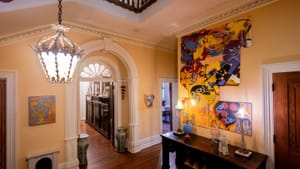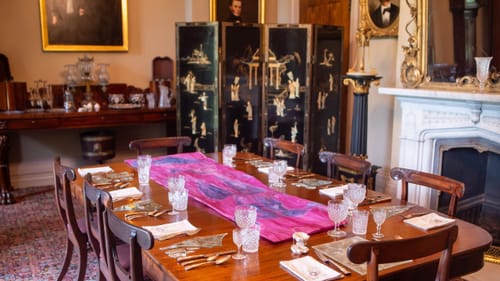Stay in the Loop
BSR publishes on a weekly schedule, with an email newsletter every Wednesday and Thursday morning. There’s no paywall, and subscribing is always free.
Victorian ghosts in modern glass
Rockwood Mansion presents Nature of Gothic

Rockwood Mansion is a somewhat brooding Victorian house museum set amid a sprawling naturalistic landscape of woods and period gardens. Nature of Gothic, an intimate, unusual, and fascinating new exhibition there, responds to its highly decorative collection and moody locale in often clever and always thoughtful ways.
Located in North Wilmington, Rockwood was built in 1821 by Joseph Shipley, a wealthy merchant/industrialist whose family came to the region via a William Penn land grant. Shipley—a dedicated Anglophile and the area’s first millionaire at a time when the duPonts were just getting established—lived and worked in Liverpool for 38 years. He then retired to his mansion, built at the height of the Gothic Revival: the 19th-century design era informed by details derived from nature.
A continuation of Shipley’s mission
Shipley was an inveterate and highly motivated collector, and there are 14,000 items of Victoriana in the Rockwood collection. Curator Ryan Grover rotates the furniture and decorative items regularly, and the mansion is a popular site for events and weddings. Its expansive grounds are the locale of Delaware Shakespeare’s summer theater, and Rockwood (reputed to be haunted) offers regular ghost tours. But Nature of Gothic is its first contemporary art exhibition.
Shipley collected the art of his time, and so Grover felt (aptly) that a site-specific exhibition inserting contemporary artists into this milieu was a continuation of that tradition. Nature of Gothic was curated by Heather Gibson Moqtaderi of Philadelphia’s Past Present Projects, an organization that specializes in placing contemporary art in historic spaces.
Referencing Rockwood’s extensive collection of Victorian decorative glass, Moqtaderi asked accomplished glass artists Leo Tecosky and Samara Weaver to respond to the museum’s holdings. The two artists created vastly different works, now on view throughout the mansion’s first floor, interspersed, juxtaposed, and sometimes almost hidden among Rockwood’s busy, distinctive collections.
Elegant, mysterious, elusive
The house’s vaulted front foyer displays Brooklyn-based Tecosky’s elegant, beautifully crafted glass pieces, works that range from amphora-like jars to unusual shapes that are slightly anthropomorphic. To center his works, the artist has decorated an elaborate (existing) period hanging lantern with his runic-like characters. Communing with the atmospheric room, Tecosky’s nine elegant, unusual pieces are displayed next to period glassware on a sideboard or on tables. He also painted a wall of brightly colored abstract panels that set off the colors of his glass, and he worked with Moqtaderi to design a striking wallpaper based on a painting detail. The house’s dimly lit foyer serves to accent the mysterious and elusive qualities inherent in Tecosky’s meticulous glasswork.
Ghosts in glass
Displayed by contrast in a bright dining room looking onto the mansion’s verdant veranda, Wilmington artist Weaver created a collection called Temporal Ghosts. Patterns of Rockwood—silver candlesticks, a marble fireplace, floral details—inspired the works. Scattered about are 50-plus small panels or shards of polished clear glass embedded with leaves, flowers, and natural items foraged from the mansion’s gardens and her own. Created from old bottles and recycled window glass and referencing Rockwood’s decorative collections, Weaver’s works also comment on the Victorian mania for pressed flowers. Some take the place of plates on the fully set, elegant dining table. While Tecosky’s vibrant works are easily located and identified, Weaver’s have a hide-and-seek quality, with tiny shards cleverly placed on windowsills or behind vases. Sound engineer and composer Justin Geller’s soundscape (sometimes apparent, sometimes receding) floats throughout the dining room.

A fitting tribute to John Ruskin
It's interesting to note that a concurrent Delaware exhibition (at Winterthur) has also asked artists to respond to its decorative arts collection. But these two offerings could hardly be more different. The intimate Nature of Gothic features the work of just two artists working within very specific confines. The exhibition’s title was inspired by 19th-century English design critic John Ruskin’s chapter titled “The Nature of Gothic” from his landmark architecture treatise The Stones of Venice.
Ruskin was a hugely influential thinker and art critic, and his three-volume The Stones of Venice set the foundation of the English Victorian Gothic that Rockwood typifies. The enigmatic pieces created by Tecosky and Weaver—so different from one another and from the milieu around them—nonetheless successfully merge with Rockwood’s air of mystery and touch clearly on its founding architectural principles. This unusual yet effective artistic juxtaposition responds cleverly to both the original artistic prompt and to the site’s relationship with the natural (and unnatural) world. Nature of Gothic slyly welcomes the viewer while (as Ruskin was so adept at doing) expanding the world in which old and new co-exist.
What, When, Where
Nature of Gothic. Through November 10, 2024, at Rockwood Park and Museum, 4651 Washington Street Extension, Wilmington. (302) 761-4340 or newcastlede.gov.
Accessibility
Historic house museums are notoriously inaccessible, but upon request, Rockwood will furnish wheelchair-accessible ramps into the Nature of Gothic exhibition galleries on the museum’s first floor. The park’s drives and some garden paths are paved.
Sign up for our newsletter
All of the week's new articles, all in one place. Sign up for the free weekly BSR newsletters, and don't miss a conversation.

 Gail Obenreder
Gail Obenreder